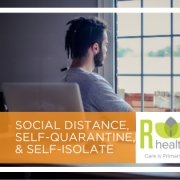SOCIAL DISTANCE, SELF-QUARANTINE, OR SELF-ISOLATE: WHATS THE DIFFERENCE?
During the COVID-19 pandemic, there has been a lot of new vocabulary being tossed around. Especially the terms social distancing, self-quarantine and self-isolate. We know these words help limit the spread of the virus but what’s the difference between them?
Social distancing refers to creating physical distance between people—6 ft apart—rather than preventing feeling close and connected to others (virtually, of course). Social distancing helps prevent sick people from coming in close contact with healthy people to better reduce the virus from spreading. Therefore, group events and concerts are being cancelled and certain public places are closing.
When it comes to self-quarantine and self-isolation both sound similar however there is a distinction between the two.
Self-quarantine in general means the separation of a person or people. In this situation, self-quarantine is referring to separating people who were exposed to COVID-19, but not yet symptomatic, and restricts them from others who have not been exposed in order to prevent the possible spread of the disease.
When a person has been diagnosed with COVID-19 and the symptoms are mild enough for the patient to be managed at home and not in the hospital—this is self-isolation. Self-isolation contains the basic elements of social distancing and self-quarantining and separates sick people from people who are not sick.
So, to keep yourself and others safe, you social distance—staying 6 ft apart. If you are at high risk of becoming sick, you self-quarantine. If you are sick or are showing symptoms of COVID-19, you self-isolate. And lastly—if you need us, we are there for you.













Leave a Reply
Want to join the discussion?Feel free to contribute!